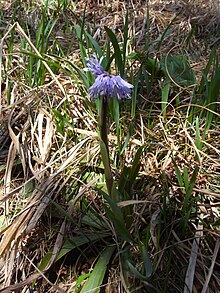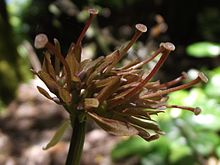Heloniopsis
| Heloniopsis | ||||||||||||
|---|---|---|---|---|---|---|---|---|---|---|---|---|

|
||||||||||||
| Systematics | ||||||||||||
|
||||||||||||
| Scientific name | ||||||||||||
| Heloniopsis | ||||||||||||
| A.Gray |
The plant genus Heloniopsis belongs to the Germer family (Melanthiaceae). The six or so species are common in Asia .
description



Appearance and leaves
Heloniopsis species grow as evergreen or deciduous perennial herbaceous plants . These hemicryptophytes or geophytes form underground, short, thickened rhizomes as persistence organs . All parts of the plant are bare.
The leaves are arranged in a basal rosette. The simple leaf blades are usually oblong to obscure-lanceolate or obovate and can be narrowed like a stalk in the lower area, with Heloniopsis koreana they are mostly spatulate. The leaf margins are smooth or slightly wavy. There is a parallel nerve.
Inflorescences and flowers
The more or less long, upright, unbranched, hollow inflorescence shafts have two to eight scale-shaped leaves. The simple, umbellate or umbel-like racemose inflorescences contain only one to ten mostly pendulous flowers. There are usually no bracts available.
The hermaphroditic flowers are radial and threefold. The six identical, durable bracts are free or, in the case of Heloniopsis tubiflora, only fused at their base and stand together like a funnel. The mostly spread out, seldom erect bracts in Heloniopsis tubiflora are spatulate or linear-inverted-lanceolate to elongated. Depending on the type, the colors of the bracts range from white with pink to pink to bluish-purple, purple with white to brownish-purple. At the base of the bracts there are nectaries in often deep pockets . There are two circles with three stamens each; they usually tower over the bracts. The mutually free stamens are often fused with the base of the bracts, but never with the ovary. The dorsifix anthers are lanceolate. Three carpels are fused together to form an upper, three- chamber ovary. Each ovary compartment contains 60 to 180 ovules . The very long, thin pen ending in a capitate stigma .
Fruits and seeds
The ascending capsule fruits are loculicidal and trilobed. The relatively small, linear seeds are tailed at both ends.
Chromosome numbers
The chromosome numbers in the examined species are 2n = 34.
Systematics and distribution
The genus Heloniopsis was established in 1858 by Asa Gray in Memoirs of the American Academy of Arts and Science , new series 6, p. 416. The type is Heloniopsis pauciflora A. Gray . Heloniopsis A. Gray nom. cons. was preserved according to the rules of the ICBN (Vienna ICBN Art. 14.4 & App. III) compared to Hexonix Raf. nom. rej. and Kozola Raf. nom. rej. which were published as early as 1836 in Constantine S. Rafinesque-Schmaltz : Flora Telluriana 2, pp. 13 and 25. Another synonym is Sugerokia Miq. The genus name Heloniopsis means similar to the genus Helonias (= - opsis ).
The genus Heloniopsis in the tribe Heloniadeae within the family Melanthiaceae . The tribe Heloniadeae previously had the rank of a family Heloniadaceae or was classified in the family of the Liliaceae . The tribe Heloniadeae contains three genera, which are all elements of the Arcto-Tertiary Geoflora. Helonias occurs in eastern North America and Ypsilandra (Vietnam via western China to the Himalayas) and Heloniopsis (Sakhalin, Korea, Taiwan and Japan) occur in eastern Asia (N. Tanaka 1997).
The genus Heloniopsis occurs in Sakhalin (one species), Taiwan (one species), Korea (three species) and Japan (three species).
There are around six species of Heloniopsis :
- Heloniopsis kawanoi (Koidz.) Honda (Syn .: Sugerokia kawanoi Koidz. , Hexonix kawanoi (Koidz.) FTWang & Tang , Helonias kawanoi (Koidz.) N.Tanaka ): This endemic occurs only on the Japanese Nansei Islands .
- Heloniopsis koreana Fuse, NSLee & MNTamura : It was first described from Korea in 2004.
- Heloniopsis leucantha (Koidz.) Honda (Syn .: Sugerokia leucantha Koidz. , Hexonix leucantha (Koidz.) FTWang & Tang , Helonias leucantha (Koidz.) N.Tanaka ): This endemic occurs only on the Japanese Nansei Islands.
-
Heloniopsis orientalis (Thunb.) Tanaka : There are three varieties:
- Heloniopsis orientalis var. Breviscapa (Maxim.) Ohwi (Syn .: Heloniopsis breviscapa Maxim. , Heloniopsis japonica var. Breviscapa (Maxim.) Honda , Hexonix breviscapa (Maxim.) FTWang & Tang , Heloniopsis breviscapa subsp. Breviscapa (Maxim.) Kitam . & Murata , Helonias breviscapa (Maxim.) N.Tanaka , Scilla japonica Thunb. , Hexonix japonica (Thunb.) Raf. , Kozola japonica (Thunb.) Raf. , Urginea japonica (Thunb.) Auct., Heloniopsis japonica (Thunb .) .) Maxim. , Heloniopsis pauciflora Maxim. nom. illeg., Sugerokia japonica (Thunb.) Miq. , Heloniopsis japonica var. yakusimensis Masam. , Heloniopsis yakusimensis (Masam.) Honda , Sugerokia yakusimensis (Masam.) Koidz. , Heloniopsis breviscapa var. yakusimensis (Masam.) H.Hara , Heloniopsis orientalis var. yakusimensis (Masam.) Ohwi ): It occurs in southern and central Japan.
- Heloniopsis orientalis var. Flavida (Nakai) Ohwi (Syn .: Heloniopsis japonica var. Flavida Nakai , Heloniopsis breviscapa var. Flavida (Nakai) H.Hara , Sugerokia nipponica Ohwi , Heloniopsis nipponica (Ohwi) Nemoto , Heloniopsis japonica var. Albiflora Honda , Heloniopsis japonica var. Tessellata Honda , Heloniopsis breviscapa var. Albiflora (Honda) H.Hara ): This endemic occurs in the southern part of the Japanese island of Honshū and on Shikoku.
- Heloniopsis orientalis (Thunb.) Tanaka var. Orientalis (syn .: Heloniopsis pauciflora A.Gray , Sugerokia japonica var. Racemosa Miq. , Heloniopsis grandiflora Franch. & Sav. , Heloniopsis pauciflora var. Rubra Koidz. , Heloniopsis japonica var. Grandiflora ( . Franch & Sav) Nakai. , Heloniopsis japonica var. purpurea Nakai , Heloniopsis japonica var. sanguinea Nakai , Heloniopsis japonica f. lateritia Nakai ex Honda , Heloniopsis orientalis var. purpurea (Nakai) Nakai , Heloniopsis orientalis f. lutea Mochizuki ): you occurs from Korea via Sakhalin to Japan.
- Heloniopsis tubiflora Fuse, NSLee & MNTamura : It was first described from Korea in 2004.
- Heloniopsis umbellata Baker (Syn .: Helonias umbellata (Baker) N.Tanaka , Heloniopsis acutifolia Hayata , Heloniopsis arisanensis Hayata ex Honda , Heloniopsis taiwaniana S. S.Ying , Sugerokia acutifolia (Hayata) Koidzumi , Sugerokia arisanensis (Hayata ex Honda) Koidzumi , Sugerokia umbellata ( Baker) Koidzumi ): It thrives on damp rocks at altitudes between 700 and 2500 meters only in Taiwan .
use
Heloniopsis orientalis is used as an ornamental plant.
swell
- Chen Xinqi (陈心启) & Minoru N. Tamura: Heloniopsis , p. 87 - the same text online as the printed work , In: Wu Zheng-yi & Peter H. Raven (Eds.): Flora of China , Volume 24 - Flagellariaceae through Marantaceae , Science Press and Missouri Botanical Garden Press, Beijing and St. Louis, 2000. ISBN 0-915279-83-5 (Description and Distribution Sections)
- Noriyuki Tanaka: Phylogenetic and taxonomic studies on Helonias, Ypsilandra and Heloniopsis : 1. Comparison of character states , In: Journal of Japanese Botany , Volume 72, Issue 4, 1997, pp. 221-228, 2. Evolution and geographical distribution , In : Journal of Japanese Botany , Volume 72, Issue 5, 1997, pp. 286-292 and 3. Taxonomic revision , In: Journal of Japanese Botany , Volume 73, Issue 2, 1998, pp. 102-115.
Individual evidence
- ↑ a b c d e f g h Rafaël Govaerts (Ed.): Heloniopsis. In: World Checklist of Selected Plant Families (WCSP) - The Board of Trustees of the Royal Botanic Gardens, Kew . Retrieved June 26, 2018.
- ↑ a b c d e f g h i Chen Xinqi (陈心启) & Minoru N. Tamura: Heloniopsis , p. 87 - online with the same text as the printed work , In: Wu Zheng-yi & Peter H. Raven (ed.): Flora of China , Volume 24 - Flagellariaceae through Marantaceae , Science Press and Missouri Botanical Garden Press, Beijing and St. Louis, 2000. ISBN 0-915279-83-5
- ↑ a b c Shizuka Fuse, NS Lee & Minoru N. Tamura: Biosystematic studies on the genus Heloniopsis (Melanthiaceae) II. Two new species from Korea based on morphological and molecular evidence , In: Taxon , Volume 53, Issue 4, 2004, Pp. 949-958.
- ↑ G. Kokubugata, C.-I. Peng & M. Yokota: Comparison of karyotypes among three Heloniopsis species (Liliaceae) from Ryukyu Archipelago and Taiwan , In: Annals of the Tsukuba Botanical Garden , Volume 23, 2004, pp. 13-16.
- ↑ First publication scanned at biodiversitylibrary.org .
- ↑ a b c Heloniopsis in the Germplasm Resources Information Network (GRIN), USDA , ARS , National Genetic Resources Program. National Germplasm Resources Laboratory, Beltsville, Maryland. Retrieved April 7, 2013.
- ^ Heloniopsis at Tropicos.org. Missouri Botanical Garden, St. Louis, accessed April 7, 2013.
- ↑ Gordon Cheers (Ed.): Botanica. The ABC of plants. 10,000 species in text and images . Könemann Verlagsgesellschaft, 2003, ISBN 3-8331-1600-5 (pages 438).
